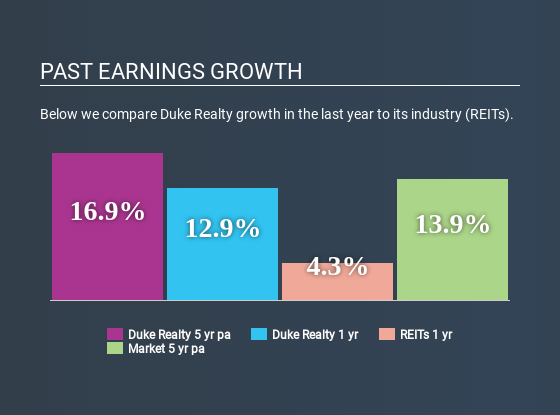Has Duke Realty Corporation's (NYSE:DRE) Impressive Stock Performance Got Anything to Do With Its Fundamentals?

Most readers would already be aware that Duke Realty's (NYSE:DRE) stock increased significantly by 6.9% over the past month. We wonder if and what role the company's financials play in that price change as a company's long-term fundamentals usually dictate market outcomes. In this article, we decided to focus on Duke Realty's ROE.
Return on equity or ROE is an important factor to be considered by a shareholder because it tells them how effectively their capital is being reinvested. In short, ROE shows the profit each dollar generates with respect to its shareholder investments.
See our latest analysis for Duke Realty
How To Calculate Return On Equity?
The formula for return on equity is:
Return on Equity = Net Profit (from continuing operations) ÷ Shareholders' Equity
So, based on the above formula, the ROE for Duke Realty is:
8.5% = US$432m ÷ US$5.1b (Based on the trailing twelve months to December 2019).
The 'return' is the amount earned after tax over the last twelve months. One way to conceptualize this is that for each $1 of shareholders' capital it has, the company made $0.09 in profit.
Why Is ROE Important For Earnings Growth?
So far, we've learnt that ROE is a measure of a company's profitability. Based on how much of its profits the company chooses to reinvest or "retain", we are then able to evaluate a company's future ability to generate profits. Assuming everything else remains unchanged, the higher the ROE and profit retention, the higher the growth rate of a company compared to companies that don't necessarily bear these characteristics.
Duke Realty's Earnings Growth And 8.5% ROE
At first glance, Duke Realty's ROE doesn't look very promising. However, the fact that the its ROE is quite higher to the industry average of 5.8% doesn't go unnoticed by us. Consequently, this likely laid the ground for the decent growth of 17% seen over the past five years by Duke Realty. That being said, the company does have a slightly low ROE to begin with, just that it is higher than the industry average. So there might well be other reasons for the earnings to grow. E.g the company has a low payout ratio or could belong to a high growth industry.
Next, on comparing Duke Realty's net income growth with the industry, we found that the company's reported growth is similar to the industry average growth rate of 15% in the same period.
The basis for attaching value to a company is, to a great extent, tied to its earnings growth. What investors need to determine next is if the expected earnings growth, or the lack of it, is already built into the share price. By doing so, they will have an idea if the stock is headed into clear blue waters or if swampy waters await. What is DRE worth today? The intrinsic value infographic in our free research report helps visualize whether DRE is currently mispriced by the market.
Is Duke Realty Efficiently Re-investing Its Profits?
Duke Realty seems to be paying out most of its income as dividends judging by its three-year median payout ratio of 64%, meaning the company retains only 36% of its income. However, this is typical for REITs as they are often required by law to distribute most of their earnings. In spite of this, the company was able to grow its earnings by a fair bit, as we saw above.
Moreover, Duke Realty is determined to keep sharing its profits with shareholders which we infer from its long history of paying a dividend for at least ten years. Existing analyst estimates suggest that the company's future payout ratio is expected to drop to 0.2% over the next three years. However, Duke Realty's future ROE is expected to decline to 4.3% despite the expected decline in its payout ratio. We infer that there could be other factors that could be steering the foreseen decline in the company's ROE.
Summary
Overall, we feel that Duke Realty certainly does have some positive factors to consider. Especially the substantial growth in earnings backed by a decent ROE. Despite the company reinvesting only a small portion of its profits, it still has managed to grow its earnings so that is appreciable. Having said that, on studying current analyst estimates, we were concerned to see that while the company has grown its earnings in the past, analysts expect its earnings to shrink in the future. Are these analysts expectations based on the broad expectations for the industry, or on the company's fundamentals? Click here to be taken to our analyst's forecasts page for the company.
If you spot an error that warrants correction, please contact the editor at editorial-team@simplywallst.com. This article by Simply Wall St is general in nature. It does not constitute a recommendation to buy or sell any stock, and does not take account of your objectives, or your financial situation. Simply Wall St has no position in the stocks mentioned.
We aim to bring you long-term focused research analysis driven by fundamental data. Note that our analysis may not factor in the latest price-sensitive company announcements or qualitative material. Thank you for reading.

 Yahoo Finance
Yahoo Finance 
